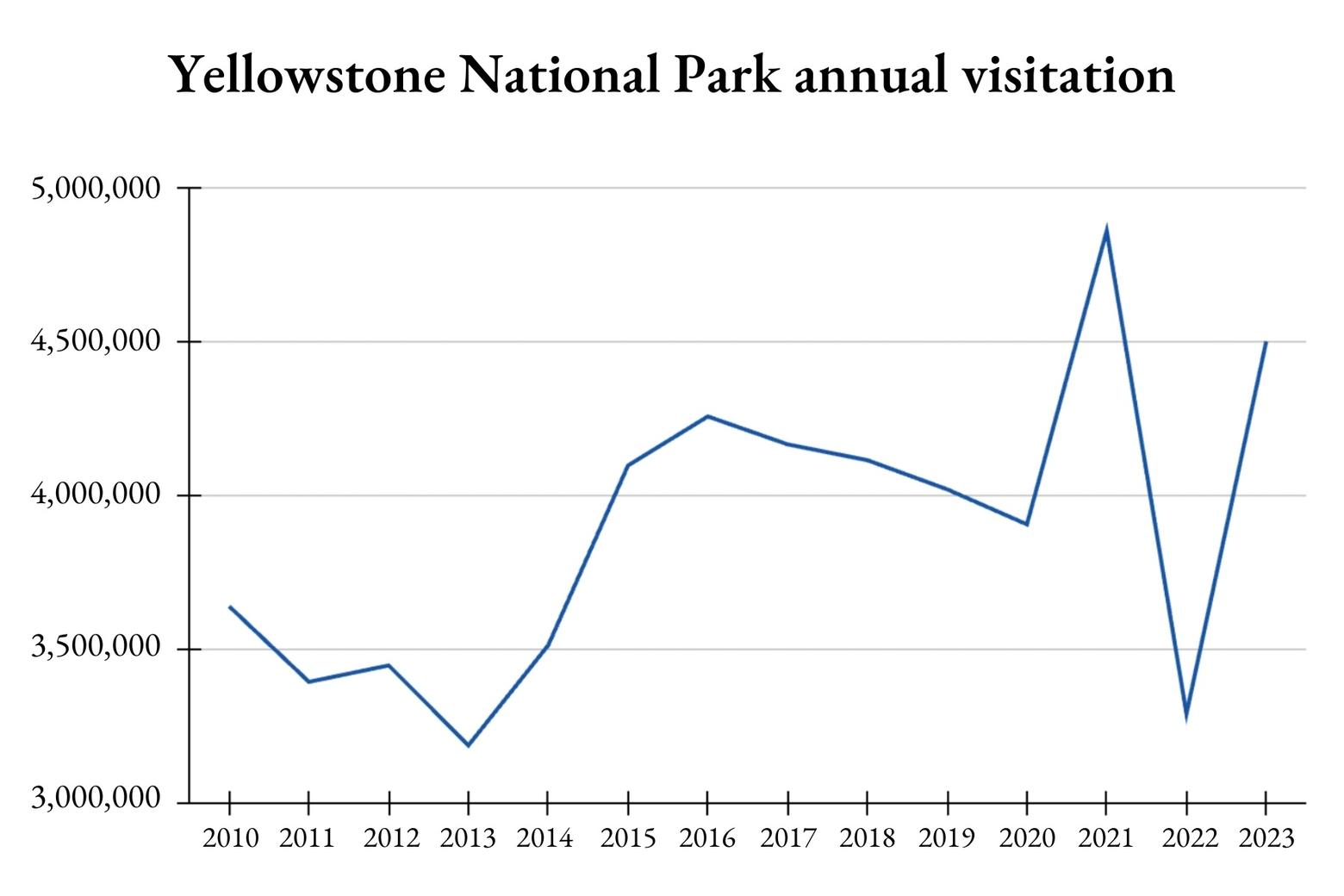Back to StoriesYellowstone Tourism Leaving Massive Carbon Footprint
April 23, 2024
Yellowstone Tourism Leaving Massive Carbon Footprint Striking new study quantifies Yellowstone tourism emissions. TLDR: it’s a lot of CO2.
by Julia Barton
A new study highlights Yellowstone National Park as an example of the
impact tourism is having on carbon dioxide emissions, citing that park visitation
produces more than a megaton of CO2 emissions annually. The average American
emits roughly 900 kg of CO2 per year; the average Yellowstone visitor, however,
emits 479 kg of CO2 during their park visit alone, the bulk of emissions coming
from travel to and from the destination.
The study, published in PLOS Climate earlier this month, aims to quantify park
emissions and explore potential reduction strategies. Tourism is a profitable
industry with emissions that are expected to increase by 161 percent in the
next decade, the study reports, and the country’s first national park acts as a
microcosm for the role tourism plays in contributing to our warming climate.
Tourism is a profitable industry with emissions that are expected to increase by 161 percent in the next decade, the study reports.
“Nature-based tourism provides numerous personal and social benefits to
tourists; it also plays an essential role in the economies of many
municipalities, counties, states, and even countries,” note the study’s authors,
comprised of researchers from Clemson and Utah State universities, and the U.S.
Geological Survey. “However, focusing primarily on the social and economic benefits
of tourism obfuscates the many environmental costs of tourism. Principal
amongst these effects are CO2 emissions, for which tourism contributes 8
percent globally.”
Yellowstone hosts more than 4 million visitors annually and attracts travelers
from across the globe. Transportation to and from the park made up 90 percent
of the annual emissions reported in the study, which uses data from secondary
sources published between 2000 and 2021. More than one-third of visitors fly to
the destination, producing nearly three-quarters of transportation-related
emissions. Transit within the park and accommodations were responsible for 5
and 4 percent of emissions, respectively. General park operations contributed 1
percent.
Tourism is also the lifeblood for gateway communities. The National Park Service
reported that
visitors spent $452 million in locales surrounding Yellowstone in 2022,
supporting 6,234 local jobs. As such, the study advocates not for decreased
visitation but rather the implementation of thoughtful reduction strategies.
“While tourism does contribute significantly to CO2 emissions globally,
tourism to parks like Yellowstone NP can lead to indirect environmental benefits,”
the study states. “Visiting parks and protected areas can increase
pro-environmental behaviors at home, some of which have been shown to reduce
greenhouse gas emissions.”
Visitors can reduce their footprint through prioritizing fuel-efficient
travel, driving instead of flying, and camping as opposed to booking hotel rooms.
Parks can decrease CO2 output by promoting regional travel and providing
emission data for reduction planning. The study notes that previous research
suggests the park is likely a “net carbon sink,” meaning its protected forests
absorb more CO2 from the atmosphere than is emitted by tourism.
While Yellowstone was the focus of the study, its research methodology
can be applied to various other tourist destinations to determine where
emissions could be reduced while maintaining visitation rates. Effective
strategies will vary, but the study emphasized that, for Yellowstone, targeting
a reduction in non-local visitors would have the largest impact.
________________________________________________________________________________________________________________________
Mountain Journal is the only nonprofit, public-interest journalism organization of its kind dedicated to covering the wildlife and wild lands of Greater Yellowstone. We take pride in our work, yet to keep bold, independent journalism free, we need your support. Please donate here. Thank you.
Related Stories
January 29, 2025
Fencing Fund Aims to Support Paradise Valley Ranchers, Wildlife
PERC launches
privately funded pilot project to address fencing issues, rancher needs and wildlife connectivity.
December 4, 2024
FWP Launches Online Dashboard to Track Grizzly Bear Deaths
As delisting
decision looms, Montana increases transparency with mortality monitoring tool.
October 25, 2024
Yellowstone Officials Call for Near-Record Bison Removal
A new bison status report proposes a winter herd reduction of more than 1,000 bison from Yellowstone National Park.






